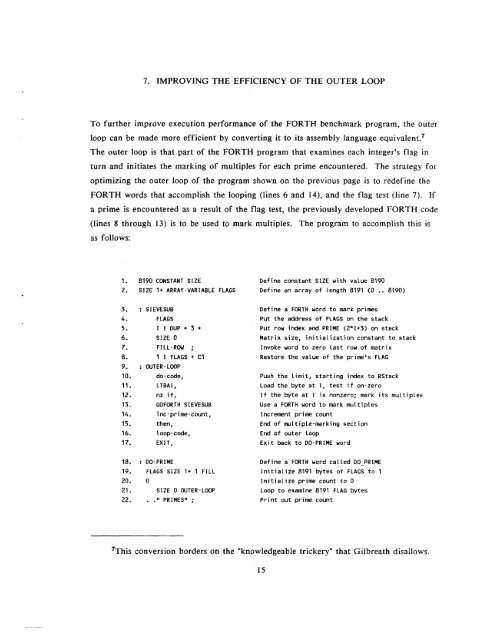Sieve of Eratosthenes benchmarks for the Z8 FORTH microcontroller
Sieve of Eratosthenes benchmarks for the Z8 FORTH microcontroller
Sieve of Eratosthenes benchmarks for the Z8 FORTH microcontroller
Create successful ePaper yourself
Turn your PDF publications into a flip-book with our unique Google optimized e-Paper software.
7. IMPROVING THE EFFICIENCY OF THE OUTER LOOP<br />
To fur<strong>the</strong>r improve execution per<strong>for</strong>mance <strong>of</strong> <strong>the</strong> <strong>FORTH</strong> benchmark program, <strong>the</strong> outer<br />
loop can be made more efficient by converting it to its assembly language<br />
The outer loop is that part <strong>of</strong> <strong>the</strong> <strong>FORTH</strong> program that examines each integer's flag in<br />
turn and initiates <strong>the</strong> marking <strong>of</strong> multiples <strong>for</strong> each prime encountered. The strategy <strong>for</strong><br />
optimizing <strong>the</strong> outer loop <strong>of</strong> <strong>the</strong> program shown on <strong>the</strong> previous page is to redefine <strong>the</strong><br />
<strong>FORTH</strong> words that accomplish <strong>the</strong> looping (lines 6 and 14), and <strong>the</strong> flag test (line 7). If<br />
a prime is encountered as a result <strong>of</strong> <strong>the</strong> flag test, <strong>the</strong> previously developed <strong>FORTH</strong> code<br />
(lines 8 through 13) is to be used to mark multiples. The program to accompiish this is<br />
as follows:<br />
1. 8190 CONSTANT SIZE<br />
2. SIZE I+ ARRAY-VARIABLE FLAGS<br />
3. : SIEVESUB<br />
4. FLAGS<br />
5. I I DUP+3+<br />
6. SIZE 0<br />
7. FILL-ROU ;<br />
8. 1 I FLAGS + C1<br />
9. : OUTER-LOP<br />
10. do-code,<br />
11. LTBAI,<br />
12. nz if,<br />
13. GOFOR T H SI EVESUB<br />
14. inc-prime-count,<br />
15. <strong>the</strong>n,<br />
16. toop- code,<br />
17. EXIT,<br />
18. : DO-PRIME<br />
19. FLAGS SIZE I+ 1 FILL<br />
20. 0<br />
21. SIZE 0 OUTER-LOOP<br />
22. . .Ii PRIMES" ;<br />
Define constant SIZE uith value 8190<br />
Define an array <strong>of</strong> length 8191 (0 .. 8190)<br />
Define a <strong>FORTH</strong> word to mark primes<br />
Put <strong>the</strong> address <strong>of</strong> FLAGS (XI <strong>the</strong> stack<br />
Put rou index and PRIME (2*1+3) on stack<br />
Matrix size, initialization constant to stack<br />
invoke word to zero last rou <strong>of</strong> matrix<br />
Restore <strong>the</strong> value <strong>of</strong> <strong>the</strong> primens FLAG<br />
Push <strong>the</strong> Limit, starting index to RStack<br />
Load <strong>the</strong> byte at I, test if on-zero<br />
1f <strong>the</strong> byte at 1 is nonzero; mark its multiples<br />
Use a <strong>FORTH</strong> uord to mark multiples<br />
Increment prime count<br />
End <strong>of</strong> multiple-marking section<br />
End <strong>of</strong> outer Loop<br />
Exit back to DO-PRIME word<br />
Define a <strong>FORTH</strong> uord called DO-PRIME<br />
Initialize 8191 bytes <strong>of</strong> FLAGS to 1<br />
Initialize prime count to 0<br />
Loop to examine 8191 FLAG bytes<br />
Print out prime count<br />
7?his conversion borders on <strong>the</strong> "knowledgeable trickery" that Gilbreath disallows.<br />
1s
















